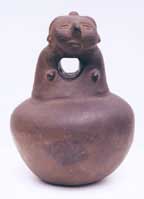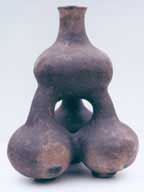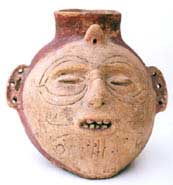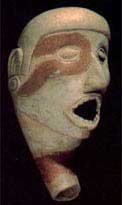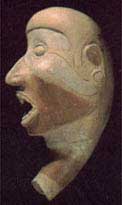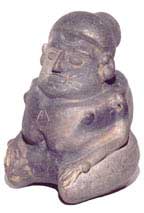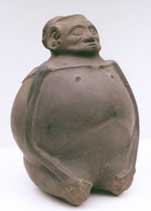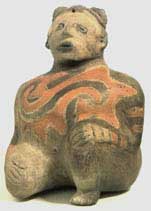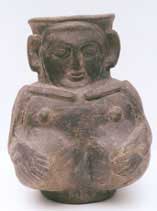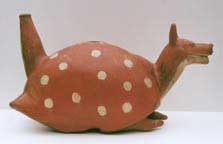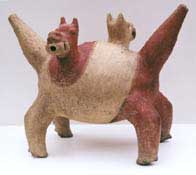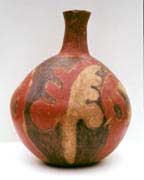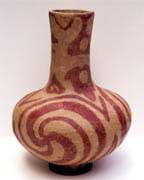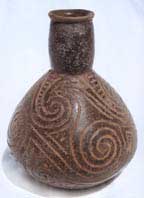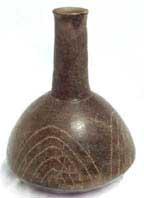 ClayHound Web
- Mississippian, Quapaw, Caddo
ClayHound Web
- Mississippian, Quapaw, Caddo Return to:
|
Mississippian, Quapaw & CADDO
POTTERY |
||||||||||||||||||||||||||||||||||
The Mississippian, Quapaw and Caddo moundbuilders produced the finest pottery of prehistoric North America. Although pottery began appearing in North America a thousand years before the Mississippians, this pre-Mississippian pottery tended to be utilitarian bowls with limited ornamentation. By contrast, the Mississippians produced pottery of great durability and high artistic merit. Archaeologists have suggested that the women of the Mississippian culture were the pottery makers. These ancient potters had no benefit of a potter’s wheel or modern kilns to produce their pottery. The Mississippians did learn to improve the strength and durability of their finished pottery by adding a tempering mixture with their wet clay. These ceramic artists began using crushed mussel shells, crushed dry clay, bone and sand to give the pottery mixture greater strength after firing. With greater strength, the potters were able to vary the appearance of their pottery, and they were no longer limited to producing pottery with only a utilitarian function.
The Mississippian
potters followed very specific steps in making their pottery. The
potters would take their mixture of wet clay and temper to make wet
clay rolls. These tempered wet clay rolls were coiled and smoothed
freehand with little technical aid to assist their artistic eyes and
skillful hands. After fashioning the final pottery vessel, it would
be left to dry. After drying, it was placed on an open fire with
little protection from the direct flames. The Mississippians lacked
any pottery kilns as we understand them today. They simply fired the
vessel in open fires until it hardened to a durable strength.
Depending on the relative heat of the fire and the color of the
local clay, the finished pottery ranged in colors from gray, brown,
black and tan. Most pottery vessels cooled to varying shades of
gray, which explains why it is called “grayware” pottery. As
artistic expression developed, the Mississippians learned to make
paints from natural materials, and these paints were used to paint
the pottery surfaces prior to firing. As the natural red, tan, black
and white paints began being used to decorate the pottery, the
vessels became more aesthetically pleasing.
The most important of the effigy forms was the head pot vessel or trophy head vessel, which depicts the human head. They are often shown with painted surfaces and engraved lines depicting tattooing. These head pots were made in a relatively limited area of northeast Arkansas and southeast Missouri and by relatively few potters. Most are painted in red and buff paint colors but some are basic grayware. By comparing the similarities of many surviving head pots, it seems that most of the surviving head pots were made by a limited number of potters. Many head pots show definite signs of use before burial, which further suggests that these important vessels were made for more than just ceremonial purposes. The Quapaw who adopted Mississippian styling techniques also
produced a limited number of head pot vessels. One such Quapaw head pot is known today at the “Screaming Quapaw”. It has painted swirl designs and ear spools. Because the Quapaw appeared in late Mississippian times, they benefited from centuries of Mississippian pottery advances. The Quapaw certainly existed in small mound groups when the Spanish traveled through Arkansas under de Soto. The first Spanish explorers to reach Arkansas had an impact on the Quapaw because the mid-16th Century Quapaw began making pottery vessels resembling European tea pots. The total known population of surviving head pots is less than 150 making them extremely rare. Unfortunately, most head pots vessels were already broken or damaged when they were found by archaeologists, so they required reconstruction and repair. Head pots range in size from 4 inches to over 8 inches in height. A head pot taller than 7 inches is a large one. It is remarkable for a large, painted head pot to survive undamaged after being in the ground for hundreds of years.
The human vessels also represent a high achievement in Mississippian art. These vessels usually depict a kneeling human figure, usually a female, in full body form with a pronounced hunched back. The legs and feet are tucked under the bottom of the vessel forming its base. Some from southeastern Missouri have an open top. The male figure is rarely exhibited and very rarely shown with genitalia. There has been much speculation to explain why these human vessels have a hunched back with vertebrae shown on the back exterior of the pottery vessels. Some have suggested that there was a cultural belief that a hunched back person had some mysterious influence and power in Mississippian society. Perhaps that is true, or perhaps the hunched back form was simply used to increase the volume capacity of the pot itself. Although human vessels were made rather uniformly, there were many stylistic variations. Some have engraving to suggest tattooing, some have holes in the ears for ear ornamentation, while still others have elaborate hairstyles. Most human effigy vessels are grayware, but some are painted with red and tan paints. Although not as rare as the head vessels, the human effigy vessels are rare and very interesting. Human effigy vessels range in size from 3 inches in over 10 inches in height. Many were broken or damaged while in the ground from heavy agricultural machinery, earthquakes and other ground moving events that have occurred over the last several hundred years. An undamaged human effigy vessel over 7 inches in height is very rare. It is often thought that the head vessels and human effigy vessels present the best image of how these prehistoric people may have looked.
The Mississippians and Quapaw also produced a great variety of animal effigy vessels. The frog, deer, fish, dog, turtle, bird and rabbit effigies have been found. Supernatural effigies have also been found such as the corn god and wild looking cat-serpents. The cultural significance of these effigy forms is unclear, but many of the effigies appear in other Mississippian artifacts. For instance, the frog seems to have been popular as it appears as the subject
of pottery vessels and stone pipes. Animal effigy vessels were made both in grayware and painted varieties. The highest concentration of effigy pottery has been found in southeast Missouri and northeast Arkansas. A lesser amount of effigy pottery has been found in Illinois, western Kentucky, Mississippi and Tennessee. The Quapaw of central Arkansas were close neighbors and trading partners with the Mississippians and shared close cultural ties. Appearing at the end of the Mississippian period, the Quapaw adopted the high artistic pottery styles of their late Mississippian neighbors. Some splendid painted animal effigies have been found at proto-historic Quapaw sites in east central Arkansas and western Mississippi. One highly unusual 16th Century Quapaw vessel from Lee County, Arkansas is that of two intertwined dogs with opposing red and tan painted swirls.
The Mississippians of
southeast Missouri and northeast Arkansas and the Quapaw of central
Arkansas and western Mississippi also produced highly decorated
painted bottles and jars. Although many lack any effigy forms, these
bottles and jars are richly adorned with fantastic painted patterns
that are uniquely Mississippian. Many exhibit painted swirls,
crosses, and geometric patterns that perhaps carry a cultural or
religious meaning. The finest of the painted Mississippian bottles
and jars were found from the Missouri boot heel to northern
Mississippi.
Where the Caddo lacked
in painted and effigy pottery, they excelled in the making of very
thin and well-proportioned pottery vessels that often exhibited
elaborate surface incising or engraving. These delicate vessels
ranged in colors from dark gray, brown and black, and the potters
often highlighted the engraved areas by embedding red ochre paint.
Caddo pottery has the same history of shell tempering as
Mississippian pottery found along the Mississippi River Valley, but
Caddo pottery tends to be smoother, thinner and more symmetrical
than pottery from along the Mississippi River. The Caddo produced
three major pottery varieties: bowls, jars and bottles. The high
water mark in Caddo pottery is found in the engraved Caddo tripod
bottles and compound bottles, and when the Caddo did produce an
effigy vessel, the quality was normally very high. |
||||||||||||||||||||||||||||||||||
|
|
||||||||||||||||||||||||||||||||||
|
From "The Mississippian Moundbuilders and Their Artifacts: http://www.mississippian-artifacts.com/html/pottery.html |
||||||||||||||||||||||||||||||||||
